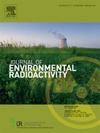Environmental radioactivity in atmospheric dust deposition samples from Northern Algeria
IF 2.1
3区 环境科学与生态学
Q3 ENVIRONMENTAL SCIENCES
引用次数: 0
Abstract
The Sahara Desert is the main source of global atmospheric mineral dust, with nearby regions, such as Algeria, within those with the highest dust deposition fluxes reported worldwide. This work aims to study environmental radioactivity and depositional fluxes in dust fallout in northern Algeria. Dust deposition samples were collected monthly using an artisan collector in Algiers from May 2014 to June 2018, and for six months in Chréa National Park. They were analyzed by gamma spectrometry for 7Be, 40K, 137Cs, 210Pb, 226Ra, and 228Th, and by WDXRF for major and trace elements. The monthly amount of dust fallout ranged from 0.5 to 33.2 g m−2, acting as an efficient trap of atmospheric 7Be and 210Pb, with average concentrations of 15 ± 10 and 2.9 ± 1.3 kBq kg−1, respectively. About 98 % of 210Pb was in excess with respect to 226Ra. Wind variability results in different dust provenances, with varying chemical compositions and varying sorption capacities for 7Be and 210Pb. Pearson's correlation matrices for temperature, rainfall, radionuclides, major, and trace elements, revealed interesting features on the behavior of the studied tracers in fallout dust. The annual 210Pb fluxes associated with dust fallout were estimated to be 186.3 ± 2.4 Bq m−2y−1 for surfaces with a retention capacity for deposited dust similar to that of the sampling device.
阿尔及利亚北部大气尘埃沉降样本的环境放射性
撒哈拉沙漠是全球大气矿物粉尘的主要来源,其附近地区,如阿尔及利亚,是全世界报告的粉尘沉积通量最高的地区。本工作旨在研究阿尔及利亚北部粉尘沉降物的环境放射性和沉积通量。2014年5月至2018年6月,在阿尔及尔使用工匠收集器每月收集粉尘沉积样本,并在chracima国家公园收集六个月。用伽马能谱法分析了7Be、40K、137Cs、210Pb、226Ra和228Th,用WDXRF法分析了主量元素和痕量元素。月降尘量为0.5 ~ 33.2 g m−2,是大气中7Be和210Pb的有效捕集剂,平均浓度分别为15±10和2.9±1.3 kBq kg−1。约98%的210Pb相对于226Ra是过量的。风变率导致不同的粉尘来源、不同的化学成分和不同的7Be和210Pb吸附能力。温度、降雨、放射性核素、主要元素和微量元素的Pearson相关矩阵揭示了所研究的示踪剂在沉降尘埃中的行为的有趣特征。对于具有与采样装置相似的沉积尘埃保留能力的表面,与尘埃沉降有关的年210Pb通量估计为186.3±2.4 Bq m−2y−1。
本文章由计算机程序翻译,如有差异,请以英文原文为准。
求助全文
约1分钟内获得全文
求助全文
来源期刊

Journal of environmental radioactivity
环境科学-环境科学
CiteScore
4.70
自引率
13.00%
发文量
209
审稿时长
73 days
期刊介绍:
The Journal of Environmental Radioactivity provides a coherent international forum for publication of original research or review papers on any aspect of the occurrence of radioactivity in natural systems.
Relevant subject areas range from applications of environmental radionuclides as mechanistic or timescale tracers of natural processes to assessments of the radioecological or radiological effects of ambient radioactivity. Papers deal with naturally occurring nuclides or with those created and released by man through nuclear weapons manufacture and testing, energy production, fuel-cycle technology, etc. Reports on radioactivity in the oceans, sediments, rivers, lakes, groundwaters, soils, atmosphere and all divisions of the biosphere are welcomed, but these should not simply be of a monitoring nature unless the data are particularly innovative.
 求助内容:
求助内容: 应助结果提醒方式:
应助结果提醒方式:


